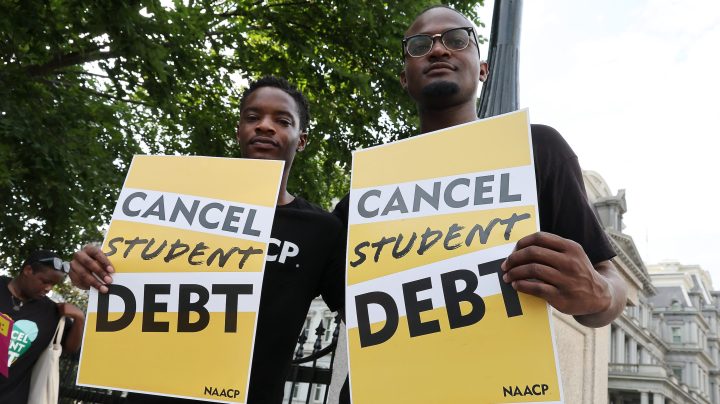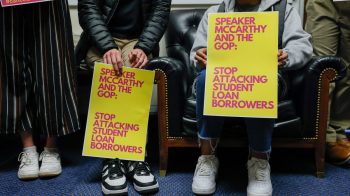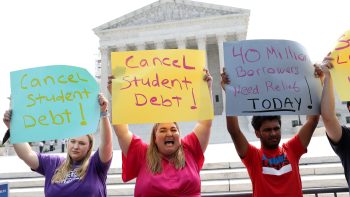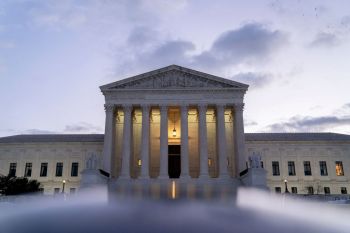
Biden’s student loan debt relief plan, explained
Share Now on:
Biden’s student loan debt relief plan, explained

Updated Oct. 17, 2022: The application is now open. You can apply for debt relief here.
Back in August, the Joe Biden administration announced its plan to forgive up to $10,000 of student loan debt for borrowers making under $125,000 and an additional $10,000 for those who were Pell Grant eligible. At the same time, the president extended the pause on loan payments for the final time through the end of 2022.
Guidance on who exactly is eligible for the existing plan and the timeline of when the relief will be available has gotten complicated. We’ve put together a guide to eligibility requirements, when to apply, and other issues about the program.
The White House estimates the plan will provide relief for up to 43 million people, and completely erase the debt of 20 million. The Pell-targeted program is set to particularly provide relief to Black borrowers, who are disproportionately burdened by student loan debt, the White House said.
Peter Granville, a senior policy associate with the Century Foundation — a think tank that studies equity in education — said the plan will remove a major roadblock to financial independence, especially for lower-income Americans.
He added that including Parent PLUS loans in the relief program was a “tremendously positive move.” Often, when undergrad loans aren’t enough to fill the gap between aid and tuition costs, lower-income families take out Parent PLUS loans that they then struggle to repay.
“If we had sufficient grant aid, those loans would never have been borrowed by parents who couldn’t repay,” said Granville. “Parent PLUS risks making low-income parents — frequently Black and Latino parents — slip backward economically.”
Betsy Mayotte, the president and founder of the Institute of Student Loan Advisors, said borrowers with high rates of default tend to have smaller amounts of debt. Amounts that will be completely forgiven by this plan.
“I’m hoping that [the plan] will really be impactful and wipe the debt away altogether from a large majority of borrowers that do have debt and no degree,” she said. “Especially if that debt is preventing them from going back to school and completing their credentials, especially if they’re already in default.”
But, Mayotte said, more could be done to relieve borrowers in the long run, as well as future borrowers.
“Student loans are the symptom, not the problem,” she said. “The problem is the cost of higher education.”
A guide to debt relief eligibility under the current plan

Now that you know whether you qualify, here’s when to apply for debt relief
ASAP — If you fully paid off your loans after the loan repayment pause began in March 2020, and you qualify for this debt relief, you can call your loan servicer now to request a partial or full payment refund. You may also need to fill out the debt relief application once it opens. Here’s a more in-depth explanation of how to qualify for a refund, what steps to take and how much to expect.
October 2022 — The form to apply for forgiveness will open. You can sign up here to get updates about the form.
Nov. 15, 2022 — The Department of Education recommends filling out the application before this date to receive relief before payments resume in January. They predict borrowers will see the forgiveness reflected in their accounts four to six weeks after applying.
Dec. 31, 2022 — Biden has extended the loan payment pause through this date. As of now, there are no plans to extend it into 2023.
Dec. 31, 2023 — The deadline to apply for loan forgiveness under Biden’s plan. But don’t wait until the last minute! Payments and interest accrual are set to resume in January 2023.
Still stumped? Here are some clarifying questions we have answers for
What documents do borrowers need to apply for forgiveness?
The Department of Education said the application will be short, and borrowers “won’t need to upload any supporting documents or use your [Federal Student Aid] ID to submit your application.” It will be available in both English and Spanish and will be accessible by phone and computer. The form will ask for your social security number.
I heard that if I’m enrolled in an income-driven repayment plan, I will automatically get loan forgiveness. Is that true?
The White House announced that 8 million borrowers may be eligible to receive relief automatically because their relevant income data is already available to the Department of Education. If you are currently on an IDR plan, you likely fall into that category. Similarly, if you completed the Free Application for Federal Student Aid, or FAFSA, this year, the Department of Education likely has your income information, so you may also get automatic forgiveness. However, it doesn’t hurt to fill out the application anyway.
I got a Pell grant in undergrad but owe graduate school loans. Do I still qualify for the additional $10,000?
Yes.
I only got a partial Pell Grant or didn’t qualify for Pell for the whole duration of undergrad. Do I still qualify for the additional $10,000?
Yes.
I’m a parent with Parent PLUS loans, and I received Pell. How much relief do I qualify for?
$20,000.
I took out Parent PLUS loans, but also owe money on my own loans from when I was in school. How much forgiveness am I eligible for?
The maximum amount a borrower can qualify for is $10,000, or $20,000 if they were a Pell recipient. Policy analyst Peter Granville said people with multiple types of loans trying to figure out how relief will be applied can think about their various student or Parent PLUS loans as individual buckets of debt.
“To find out how much cancellation you’re owed, the Education Department will pour all of your loans into one bucket with your name on it,” he said. “From that big bucket, it will subtract up to $10,000, or up to $20,000 if you received a Pell Grant.
Wait, do I have to prove I received Pell? How will the Department of Education know?
The Department of Education has data on which borrowers received Pell in college. You will not need any documentation to “prove” Pell eligibility.
I’m still in school. Can I qualify for debt relief?
Yes, current college students are eligible for Biden’s loan forgiveness. If you are defined as a dependent by the Department of Education, eligibility is based on your parents’ income.
The student aid website says: “If you were enrolled in school as a dependent student for financial aid purposes between July 1, 2021, and June 30, 2022, your eligibility is based on parent income. After you fill out your own application form, we’ll contact you so your parent(s) can complete a Parent Income Form.”
I took out a loan for this school year and otherwise qualified for debt relief. Can the loan from this year be forgiven?
The plan is only for loans that were fully disbursed by June 30, 2022.
I am a recently graduated student. Am I still considered a dependent by the Department of Education?
Debt relief eligibility is based on how the Department of Education records your income between July 1, 2021, and June 30, 2022. If, for example, you graduated in May 2022 and are now fully independent, eligibility would still be based on your parent’s/parents’ income.
More information about dependency status as defined by the Department of Education can be found here.
My partner and I aren’t sure if we’re over or under the income cap. How will they determine income?
If you’re not sure where you fall or are on the cusp of the income cutoff, the determining number is your adjusted gross income. Married couples that file together or heads of household must have an AGI under $250,000 to qualify. Otherwise the cap is $125,000.
“If you think you might qualify, it can’t hurt to submit the application.”
Peter Granville, the Century Foundation
I continued to make payments after the March 2020 payment pause was announced and otherwise qualified for this debt relief plan. How much of a refund can I expect?
According to Studentaid.gov FAQ, if you apply for and receive debt relief under this plan and your payments since the pause began brought your balance below the maximum amount of relief you qualify for, but you did not pay off your balance in full, you can get a refund.
Here is the example scenario they give: “If you’re a borrower eligible for $10,000 in relief; had a balance of $10,500 prior to March 13, 2020; and made $1,000 in payments since then—bringing your balance to $9,500 at the time of discharge—we’ll discharge your $9,500 balance, and you’ll receive a $500 refund.”
If you paid off your loan in full since the payment pause began, you may need to call your loan servicer to request a refund. More information can be found here.
I’m not sure if my FFEL loans are commercially held or government held. How can I tell?
Most Federal Family Education Loan Program and Perkins loans are commercially held. Some, however, are held by the government and therefore would be eligible for forgiveness. If your loan was eligible for the pandemic payment pause, that indicates your loans are government held. You can also check your loan status at Studentaid.gov to confirm your loan servicer. If the servicer is the Department of Education or is identified as Nelnet, that also means your loans are government held.
I have FFEL loans that are commercially held, so I don’t think I qualify for this plan. What can I do?
When announced, the Biden-Harris debt relief plan said that borrowers with privately held federal student loans, like FFEL and Perkins loans, could consolidate their loans to qualify them for forgiveness. However, the administration reversed that decision at the end of September and limited forgiveness to government-held student loans only. If you did apply to consolidate before Sept. 29, 2022, then your loans are eligible.
Currently, the Department of Education guidance on FFEL or other commercially held loans is this: “ED is assessing whether there are alternative pathways to provide relief to borrowers with federal student loans not held by ED, including FFEL Program loans and Perkins Loans, and is discussing this with private lenders.”
I defaulted on my loans. Am I really eligible?
Yes, all federal defaulted loans are eligible for relief. That includes defaulted commercially held federal loans. If you still owe money on your loans after this debt relief, you can apply to the Fresh Start initiative, which extends beyond the payment moratorium and is designed to help borrowers in default.
I thought that Biden’s plan extended beyond this immediate debt relief. What about the rest of the plan?
When the plan was announced, the Biden administration outlined a plan that included covering borrowers’ unpaid monthly interest and lowering monthly payments for undergraduates. However, there are no draft regulations for this part of the plan yet.
“It’s a little premature to really talk about it,” said Betsy Mayotte with ISLA. “We won’t really know what it’s gonna look like until the final rules come out, which isn’t going to be for months.”
How much will the loan forgiveness program cost?
The Department of Education estimates one-time student debt relief will cost around $30 billion a year for the next decade, or around $305 billion total. For context, the Department of Defense requested a budget increase of around $30 billion, or 4%, for the 2023 fiscal year, bringing its total budget to $773 billion for the year.
There’s a lot happening in the world. Through it all, Marketplace is here for you.
You rely on Marketplace to break down the world’s events and tell you how it affects you in a fact-based, approachable way. We rely on your financial support to keep making that possible.
Your donation today powers the independent journalism that you rely on. For just $5/month, you can help sustain Marketplace so we can keep reporting on the things that matter to you.


















